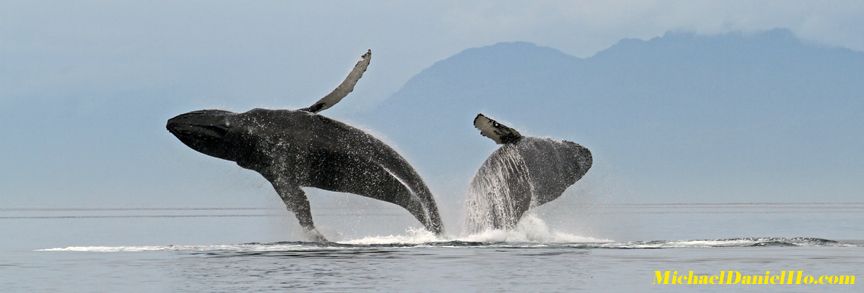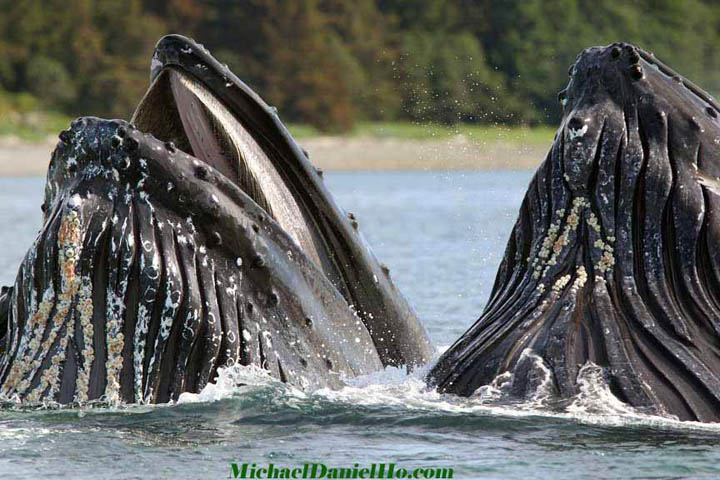Wildlife photographer Michael Daniel Ho took time from his busy schedule to answer a few questions about traveling to Alaska. This remote state happens to be one of the places where he has taken many of his amazing photos, including several of my favorites. If you’ve been thinking about traveling to Alaska, definitely go! Just make sure you take time to plan the trip and read Michael’s answers to the following questions, he’s an expert Alaska traveler. (Also, to see more of Michael Daniel Ho’s photos, visit his website.)
Q. Where is the best place to see whales in Alaska?
A. Alaska is the largest state in the U.S., with a land mass of over 663,000 square miles and a population of a little over 700,000 people. The seas around Alaska are distinctly different from lower latitude seas. They are rich in phytoplankton, which is the base of the food chain for all marine and coastal Alaskan wildlife and people. From the Chukchi Sea to the Gulf of Alaska, all the way down to the Inside Passage, a profusion of wildlife, ranging from walruses, seals, sea lions, bears, whales, eagles, etc. to untold millions of salmon, fish and seabirds thrive on this rich environment. Some of the best places to see whales are in the Chukchi Sea, SE Alaskan waters, the Inside Passage and the waters around the Kenai peninsular.
Q. What kind of whales can you see?
A. Many cetaceans live in and around Alaskan waters. Blue, humpback, bowhead, fin, minke, gray, orca, beluga, narwhal are some of the species one may encounter depending on the time of the year. The most common whales one can see on a whale watching trip are the humpbacks, orcas, grays and belugas, depending on location and time of the year.
Q. When is the best time of year to see whales?
A. Wildlife encounters are always unpredictable, but generally speaking, the best time to go on a whale watching trip is around the summer months, from June to September. May and October are considered shoulder months and encounters may be fewer. Q. Is it possible to see whales from shore or is it better to go on a local whale watching boat? If so, do you have a recommendation?
A. It is possible to see whales from shore. I have seen humpback whales bubble net feeding less than one hundred feet from shore, but that is a rare exception. There are some islands and inlets in the Inside Passage that whales do visit but not on a predictable basis. The best chance to see whales is go with a reputable whale watching company. Generally, most whale watching companies utilize boats ranging in size from small to large, carrying anywhere from 6 to 100 people or more. Whenever possible, I always go on a zodiac because it is faster and less crowded, but zodiac whale watching is rarely available in Alaska.
Q. Do you have any travel tips on getting to and around Alaska? Is it necessary to rent a car?
Getting around Alaska is not easy and can be expensive because there are only a few main road systems and the rest of the state is very pristine and wild. For most people, flying into Seattle or Anchorage would be the start of their Alaskan adventure, if they are visiting the Southeastern or Northern part of the state, respectively. Fortunately, there is the robust Alaska Marine Highway Ferry System to connect most cities and towns. In addition, Alaska Airlines and its subsidiary, Horizon Air, can fly visitors into many big and small towns. Lastly, there is an army of bush pilots and a fleet of small planes and seaplanes ready to take adventurous photographers into almost anywhere not reachable by other modes of transportation. For the first time visitor, I advise sticking to one or two National Parks or towns and try not to overextend oneself. Renting a car can be expensive and the price of gas is much higher than in the lower 48 states. Careful pre-trip planning is a must and having wheels may or may not be necessary, depending on the places one is visiting.
Q. Do you have a favorite place to stay?
I love visiting Alaska. It is truly the Last Frontier of the United States, with stunning land and seascapes, fascinating floral and fauna to keep me going back year after year. During the past few years, I have been more enamored with SE Alaska. The climate is mild, by Alaskan standards and there are a large number of small tour and whale watching companies and individual guides offering their services. The wildlife action is good and the region is closer to California, my home state, so I save on travel time as well.
Q. Is it best to book really early if it’s the busy season?
Yes, there is no substitute for planning and booking early. Depending on the wildlife one is after, some places are strictly limited by visitor permits and they go on a lottery system and can be allocated months in advance. Good and small whale watching companies fill their boats quickly, especially during the summer months when there are cruise ships in the ports.
Q. How much time should be allocated for a trip to Alaska?
I would allocate at least one to two weeks and stick to one or two national parks or towns. Since Alaska is so big, one can spend a couple of days just traveling from one place to another. That’s why I try to use one or two places as the base for exploration and touring.
Q. What type of gear / clothing is good to have along?
Protected by the Chugach Mountains and the Alaska Range and warmed by Pacific Ocean currents, Anchorage, the largest city in the state, has a temperate maritime climate. Summer temperatures can reach into the high 70s. Low humidity also contributes to Anchorage’s comfortable climate. SE Alaska’s climate can be milder, by Northern Alaskan standards but the whole state can experience snow any time of the year, depending on elevation and latitude. Temperatures can vary greatly depending on the region one may visit. Therefore, careful clothing selection is important to anticipate the unexpected. The best advice is to dress in layers, whether one is hiking in the wilderness or just walking around town and always have a waterproof parka available at all times because Alaska’s weather is unpredictable and wet most of the year. A pair of high quality hiking boots is essential for those who do a bit of walking around as well.
Q. What type of camera equipment do you recommend bringing?
For the causal photographer who wants to leave Alaska with some decent photos of its amazing wildlife and scenery, I would recommend bringing a DSLR camera with at least two different lenses. A camera with a burst rate of at least 5 frames per second and a sensor of about 10+ megapixels plus two zoom lenses of say, between 15 to 50mm (landscape) and 70 to 300mm (wildlife). For the more serious photographers, please visit my website and look under the Equipment and Article sections to get more information.


Leave a Reply